|
|
|
Sort Order |
|
|
|
Items / Page
|
|
|
|
|
|
|
| Srl | Item |
| 1 |
ID:
124451
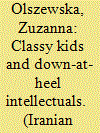

|
|
|
|
|
| Publication |
2013.
|
| Summary/Abstract |
This article reviews the ways in which class, status, social mobility and their cultural ramifications have been considered (or failed to be considered) in recent ethnographic studies of the Islamic Republic of Iran. It argues against the trend of privileging "resistance" to an oppressive state as a theoretical frame for documenting social phenomena in Iran: lifestyles and consumption patterns cannot be interpreted merely as signs of political rebellion because they are endowed with symbolic value as status attributes in a society whose class configurations are shifting. I present a number of sources and concepts that help to rethink these phenomena, and show how the experience of Afghan refugees living on the margins of Iranian cities illuminates both the opportunities and constraints created by the Islamic Republic's uneasy mix of political Islam, populism and neoliberalism. A focus on aspiration to upward mobility becomes a useful analytical lens that allows us to sidestep reductive dichotomies such as tradition/modernity or religion/secularism that are in practice blurred by its very pursuit.
|
|
|
|
|
|
|
|
|
|
|
|
|
|
|
|
| 2 |
ID:
124459
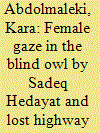

|
|
|
|
|
| Publication |
2013.
|
| Summary/Abstract |
In feminist theory, the "female gaze" is a reaction to the imbalance of power created by the "male gaze". Yet, since the concept lacks sound grounding in theory, it solely poses "a simple (antagonistic) response" to male voyeurism. This article traces the manifestations of the female gaze in Lost Highway and The Blind Owl, a film noir and a novella. It is concluded that instead of offsetting the imbalance of power, the female gaze only reverses it, turning the concept into yet another catchphrase of patriarchal hegemony to further commodify and subjugate women.
|
|
|
|
|
|
|
|
|
|
|
|
|
|
|
|
| 3 |
ID:
124463


|
|
|
|
|
| Publication |
2013.
|
| Summary/Abstract |
Da (Mother): Memoirs of Seyyedeh Zahra Hoseini, as Recorded by Seyyedeh A'zam Hoseini was published by Sureh-ye Mehr, the official publisher of the Artistic Center of the Islamic Development Organization, in 2008. According to the publishers, it became the biggest seller in the shortest period in Iranian publishing history. This article analyzes the conditions of production, distribution and reception of that work, and compares it to the canon of other contemporary Iranian war narratives. It argues that the unusually wide and varied reception of a traditional discourse of sacrifice, nationalism and revolutionary fervor was facilitated by the fashionable format of the woman's memoir, in addition to a formidable propaganda machine.
|
|
|
|
|
|
|
|
|
|
|
|
|
|
|
|
| 4 |
ID:
124464
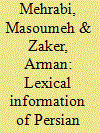

|
|
|
|
|
| Publication |
2013.
|
| Summary/Abstract |
This article investigates the nature of lexical information in the lexical entries of Persian transitive verbs. In the first experiment transitive verbs were categorized into five groups. What differentiates them is the number of argumental structural and subcategorization frame options of each verb. The question is: which one is more fundamental in sentence processing? In the second test the question is whether the number of argument(s) and complement(s) in each option determines processing time. Twenty normal native speakers of Farsi participated in these tests, divided into two groups. Cross-modal lexical decision method was used here. Using the DMDX software program the tests were performed and using t-tests the data were analyzed. The results of the first test show that both the argumental structure and subcategorization frame possibilities of the verb can affect sentence processing time. Also the important role of the number of the complement(s) needed for a specific verb has been indicated by the second test results. Overall results show that the verb type of a sentence and sentence syntactic complexity determine the processing time. This has some implications for teaching Farsi to foreign language learners for whom knowing more verbs leads to making more grammatical sentences.
|
|
|
|
|
|
|
|
|
|
|
|
|
|
|
|
| 5 |
ID:
124469
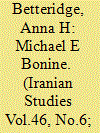

|
|
|
|
|
| Publication |
2013.
|
| Summary/Abstract |
Michael Edward Bonine passed away on 21 December 2011 in Tucson, Arizona at 69 years of age. From 1975 to 2011 he enjoyed a distinguished career as a faculty member at the University of Arizona, where he was Professor of Geography and Regional Development and Professor of Near Eastern Studies. Bonine brought the Middle East Studies Association national headquarters to the University of Arizona, and served as MESA's Executive Secretary from 1981 to 1989. He headed the Department of Near Eastern Studies from 2001 into 2011, and was founding director of the School of Middle Eastern and North African Studies, established in July 2011. The arc of his career in many respects paralleled and encouraged the development of Middle Eastern Studies at the university.
|
|
|
|
|
|
|
|
|
|
|
|
|
|
|
|
| 6 |
ID:
124467
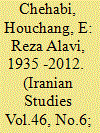

|
|
|
|
|
| Publication |
2013.
|
| Summary/Abstract |
Reza Alavi Shooshtari was born in Ahvaz on 7 September 1935. After attending Alborz High School for three years-an experience he did not enjoy because he found the school's ethos too authoritarian-he left Iran in 1950 for the United States and completed his secondary education at the Gilman School in Baltimore, Maryland. He entered Harvard College upon graduation in 1953. A resident of Leverett House, he graduated in 1957 with a concentration in History. Upon his return to Iran in the same year, he studied Persian literature in the traditional manner at Tehran's Sepahsalar Madrasa. In 1959 he went up to Oxford and, as a senior undergraduate at St. Antony's College, read Sanskrit under Thomas Burrow, the Boden Professor of Sanskrit, and R.C. Zaehner, the Spalding Professor of Eastern Religions and Ethics. He held a deep interest in early Buddhism and Upanishadic philosophy, and in the summer of 1960 first visited India to spend some time at an ashram so as to immerse himself practically in Indian philosophy. He received his second BA in Oriental Studies from the University of Oxford in 1962. While at St. Antony's, he also collaborated with Albert Hourani on organizing seminars on Persian literature and history at that college's recently established Middle East Centre. Encouraged by Hourani and Zaehner, he decided to pursue a doctorate at Oxford, for which he was awarded one of the prestigious Boden Scholarships to study Sanskrit and Pali.
|
|
|
|
|
|
|
|
|
|
|
|
|
|
|
|
| 7 |
ID:
124470
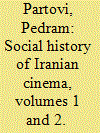

|
|
|
|
|
| Publication |
2013.
|
| Summary/Abstract |
Hamid Naficy has finally rewarded readers with his long-planned and eagerly anticipated multi-volume history of Iranian cinema. The first two volumes reviewed here, covering the late Qajar and Pahlavi eras (1897-1978), were first published in September 2011. The third volume, subtitled "The Islamicate Period, 1978-1984," reached press in late spring 2012. The fourth and final volume, on "The Globalizing Period, 1984-2010," was published in November 2012. The sheer size of Naficy's undertaking signals its importance to the field and to the author. It is in many ways a life's work. In fact, the biographical preface to the first volume describes a lifelong engagement with cinema that has informed this project. Naficy presents the end product as the culmination of nearly four decades of research and writing. But his personal investment in the work is not the sole justification for it. Within its pages, Naficy forcefully makes a case for cinema's centrality to Iranian life-its images, voices, and ideas pushing and pulling a society in transition towards and away from modernity.
|
|
|
|
|
|
|
|
|
|
|
|
|
|
|
|
| 8 |
ID:
124465


|
|
|
|
|
| Publication |
2013.
|
| Summary/Abstract |
The paper consists of six parts. The first part discusses the major reasons for the presence of a conventional sociopolitical Baloch culture in Iran. The second part presents a profile of the Iranian Baloch elites, dividing them into four major groups: the Sunni clerics or molavis, tribal chiefs, the educated, and the wealthy. The third discusses the challenging relationship which exists among the Baloch elites. The fourth describes the elites' attitudes towards the Baloch society's norms. The fifth determines the elites' orientation towards state and politics. And finally the paper ends with conclusions.
|
|
|
|
|
|
|
|
|
|
|
|
|
|
|
|
| 9 |
ID:
124454
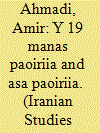

|
|
|
|
|
| Publication |
2013.
|
| Summary/Abstract |
Yasna 19 contains an Avestan exegesis of the G?thic stanza Ahuna Vairiia, the most revered text in Zoroastrianism. The stanza is traditionally understood to be the essential statement of the religion of Mazd?. Thus, in Y 19 we have a unique opportunity to ask about the significance that the G?th?s of Zarathuštra held for the later Avestan tradition. In what intellectual horizon did Zoroastrian priests place their founding text? Although Y 19 exegesis of the Ahuna Vairiia contains semantic obscurities, it is possible to establish the meaning of the commentary through syntactic and conceptual analysis of two key terms and the phrases where they occur. The article critically examines the earlier interpretations of the text. Having found these inadequate, it proposes a new reading and understanding of the Avestan exegesis. In particular, the article argues that the Avestan exegete understood the G?thic stanza within an eschatological horizon.
|
|
|
|
|
|
|
|
|
|
|
|
|
|
|
|
|
|
|
|
|